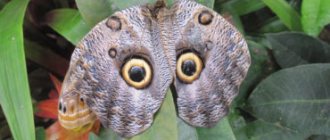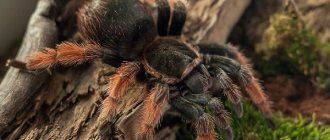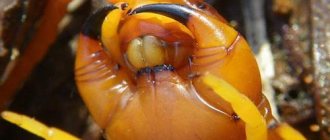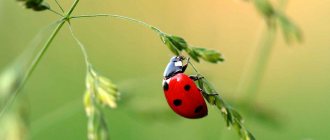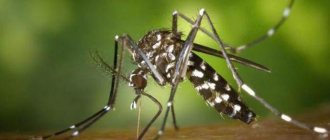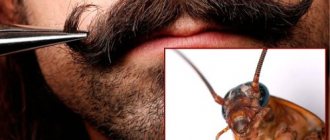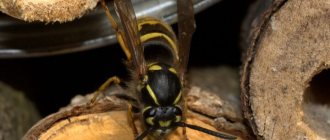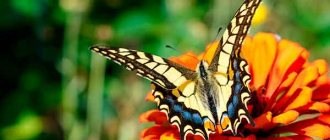The scientific name of the death's head butterfly is Acherontia atropos. A diurnal butterfly of the hawk moth family (the largest hawk moth in Europe). It got its name for the yellow pattern in the form of a skull and crossbones on a dark brown back. The body length is about 6 cm, and the wingspan is up to 13 cm. The butterfly is considered the heaviest on earth - its weight reaches 9 grams.
The hawkmoth caterpillar is up to 15 cm long and has a curved horn. There are different colors: yellow-blue, green, brown.
The death's head usually feeds on nightshade plants (potatoes, nightshade, belladonna, dope, tobacco), and sometimes others: jasmine, raspberries, lilacs.
The Death's Head butterfly can be found in apiaries, where it sucks honey, above warm valleys and low mountains. It is interesting because when irritated it makes a high-pitched squeaking sound. The frightening coloring and strange sounds that the moth makes have given rise to incredible rumors.
The death's head is a butterfly with a wingspan of up to 13 cm, which belongs to the order of hawk moths. Another name for the butterfly is also known - Adam's head. This insect is the largest in Russia. In Europe, it is the second largest in size - the lead in body size is Saturnia pear. The death's head hawk moth is easily recognizable due to its characteristic color - on the body of the insect there is a bizarre pattern that vaguely resembles a human skull. For this feature the butterfly received its Russian name. Most European peoples gave it similar names. Its eerie appearance has made this insect a popular character in horror books and films.
Description of the species
The death's head moth was first described in the scientific literature in the work Systema naturæ by Carl Linnaeus. In his work the insect is referred to as "Sphinx atropos". In 1809, the German entomologist Jacob Heinrich Laspeyres transferred the hawkmoth of this species to the genus Acherontia (this is a reference to the Acheron River, located in the kingdom of Hades), to which the butterfly is still classified today.
The front wings can be from 40 to 50 mm, but cases have also been recorded when their size reached 70 mm. The size of the wings varies between males and females. For the former it ranges from 90 to 115 mm, for the latter – from 100 to 130 mm. The front wings have a smooth outer edge. They are much longer than wide - the difference can be 2 times or more. The rear wings have slightly different proportions compared to the front ones - they are 1.5 times longer, and a strong bevel towards the rear edge is noticeable.
The weight of individuals can be from 2 to 8 g, with females being heavier than males. The color of the insect's head is most often black. On the chest of the butterfly you can see a frightening yellow pattern that looks like a human skull. However, some species lack this feature - for example, Acherontia atropos f. Obsoleta.
The coloring of males and females differs. In males, most of the abdomen is colored ocher-yellow; the color also includes gray-blue or black. In females, only the last segment has this coloration. The hawk moth of this species has an impressive abdomen, covered with scales, the length of which can be up to 60 mm with a diameter of up to 22 mm. There is no brush of scales at the end. The abdomen varies in shape - in males it is slightly pointed, and in females it is rounded.
The insect's eyes are round. The proboscis is short – from 10 to 14.5 mm. The palpi are well developed, slightly curled upward. The outside is covered with scales. The short antennae bend slightly before the apex. The legs are strong and short.
The death's head usually rests during the day, choosing tree trunks and stumps to remain invisible to others, and is awake at night. Butterflies can be seen at night in the light of lanterns and lamps.
In case of danger, insects first try to scare the enemy - they flap their wings loudly, make unusual sounds, and then try to hide as quickly as possible, choosing secluded places for this. Disturbed butterflies prefer to hide in crevices in the bark or under leaves. In case of danger, males can release a special substance from the glands to scare away opponents, the smell of which vaguely resembles the smell of mushrooms.
There are three types of butterflies, the name of each of which is associated with ancient myths:
- Atropos was the name of the Greek goddess of fate, who cut the threads of lives;
- Styx – river of the dead;
- Lachesis is the goddess of fate who measures the duration of life.
Butterfly hawk moth: description
The hawk moth is considered a rather interesting and amazing insect, resembling hummingbirds in appearance.
Different species of these insects are active at different times of the day: some fly during the day, others in the evening, after sunset, and others even at night. At the same time, you can see insects with very original body colors, so many owners cannot determine what kind of species it is. Nature of life:
- Adults grow up to 11 cm in length and have a proboscis up to 10 cm in length. The wingspan of the butterfly is 65-120 mm.
- The insect is capable of flying at speeds of up to 50 km/h.
- The hawkmoth butterfly flies over flowers, hovers over them and feeds on the nectar of flowers.
- The complete development cycle of such an amazing creature consists of 4 stages: a caterpillar (larva) appears from the egg, which after a certain time turns into a pupa, and an adult flies out of the pupa and lays eggs. This lasts from 30 to 45 days, so over the summer 2 generations of these amazing creatures are born.
- Adults emerge at the end of June and perfectly complement the greenery with their outfits. They begin to fly around flowering trees and shrubs, such as apple, pear, lilac, chestnut, pollinating them.
- The larvae of the hummingbird butterfly are quite large and can reach a length of about 12.5 cm. At the same time, they are distinguished by the original, bright pattern of their body. Some species have a fantastic range of colors: green with a lemon tint, white with black and yellow spots, brownish-gray with “painted” eyes on the front of the body. As a rule, they look like creatures, as if from another planet.
- A characteristic feature of the hawk moth caterpillar is the presence of a horn at the end of the body. The color of the horn depends on the type of butterfly and may have original colors.
- Before turning into a butterfly, becoming a pupa, the caterpillar changes its color. Before becoming a pupa, the caterpillar has already accumulated the required amount of nutrients and hides in the ground. After 18 days, a rather beautiful hawkmoth butterfly emerges from the pupa. As soon as the wings dry, the butterfly takes flight to find a sexual partner and lay eggs to prolong its kind.
Additional factors:
- If you take a hawk moth caterpillar, it does not cause disgust and behaves quite calmly or moves slowly. Many people are afraid of caterpillars, but this caterpillar does not bite and cannot harm humans.
- The caterpillars feed on young leaves. The wine hawk moth prefers to settle on the grapevine. The caterpillar is large in size and has a very warlike coloring, with a spike at the end. The caterpillar has a rather unusual appearance, so many owners do not try to destroy it, constantly watching it. After some time, I manage to see a beautiful butterfly.
- The tongue hawk moth is similar in appearance to a small bird. It can often be seen in the garden, and children who have seen this creature say that they saw a small, unusual bird in the flower garden.
- The death's head hawk moth is distinguished by the fact that it has a pattern on its chest similar to a skull or a design that was found on pirate flags. This is one of the largest butterflies of the hawkmoth species. It feeds on both the sap of young trees and honey. This butterfly can easily climb right into the hive, making sounds like a young queen makes sounds. Therefore, she calmly steals honey from the bees. They do not touch her, as they mistake her for one of their relatives.
- Bedstraw hawk moth is more common in the middle zone. It has a long proboscis and a dense body. At the same time, the body color is a combination of brown and beige, and orange splashes are visible on the tips of the wings.
These insects are also called sphinxes. This is due to the fact that the disturbed caterpillar raises the front part of its body and freezes in a sphinx pose.
There are several types of hawk moths:
- Euphorbia.
- Wine.
- Pine.
- Dead Head.
- Ocellated.
- Oleander.
- Convolvulus.
- Lilac.
- Proboscis Hawkmoth and many others.
Interesting to know! Scientists know about more than 1000 species of these insects. There are species that constantly migrate, making long-distance flights, as well as flying from continent to continent.
Butterfly “hummingbird” – Hawk Moth. Watch this video on YouTube
Singing butterfly
One of the features of this species of butterfly is the ability to make unusual sounds. Not only the butterfly is endowed with this skill. Both the pupa and the caterpillar can “sing,” and at different stages of development the insect’s voice differs significantly.
Scientists have been interested in this feature since ancient times. So back in the 18th century, the Dutchman Jan Swammerdam tried to understand how a butterfly makes sounds, but could not find the answer. In the 19th century, research was carried out by the Frenchman Reaumur, but luck did not smile on him either. The riddle was solved only in 1920. It's all about the special structure of the insect's pharynx - when air is drawn in, its pharynx works like bellows. The thin film in the crop begins to vibrate and an unusual sound appears.
In 2006 and 2007, tourists vacationing in Mexico, where there were many butterflies of this species, were amazed by the collective singing of insects.
Beliefs associated with a butterfly
It is believed that a meeting with a “death’s head” foreshadows the death of one of the family members. To prevent this from happening, the butterfly should be killed.
If a scale from a hawk moth's wing gets into the eye, it will lead to inevitable blindness and quick death.
In 1733, a smallpox epidemic in France wiped out thousands of lives. The superstitious French associated the arrival of misfortune with the appearance of a “death’s head” in these places.
Is it possible that the “dead head” hawk moth is a butterfly that brings death, disease, war, epidemics, devastation and hunger? Of course, this is a monstrous heresy, although impressionable people still attribute such properties to a large insect. But butterflies are not even carriers of diseases dangerous to humans, unlike lice and many mammals.
Habitat of Acherontia atropos
The dead head insect can be found in Africa, Saudi Arabia, Iraq, Iran and other countries. It is widespread in the subtropical and tropical zones. In addition, the butterfly is found in Central and Southern Europe. In Crimea, seeing a death’s head is a real success, because it is practically not common there. On the territory of Russia, this species was seen only in some areas - for example, in the Moscow, Kaluga and Krasnodar regions. The butterfly can also be found in Armenia, Azerbaijan and Abkhazia.
Hawkmoths annually fly north, where they form temporary colonies. The distances that butterflies travel vary depending on weather conditions. In some years, the insects even reach Iceland.
In the mid-19th century, there were so many hawkmoths of this species in England that farmers decided to use the insects to feed poultry.
In Africa, where conditions are most suitable for hawk moths, the butterfly can be seen all year round. Butterflies move very quickly, their speed can be up to 50 km per hour. They prefer to settle in sunny areas located in lowlands overgrown with grass and shrubs. You can see a dead head in deciduous forests, but in mountainous areas they are rare guests and are listed in the Red Book.
What are the characteristics of reproduction and life cycle duration?
Butterflies live and reproduce throughout the year. As a rule, 2 generations mature during this time. Sometimes their number can increase to 3. This is likely if the necessary conditions are present.
Insect eggs are round. The diameter does not exceed 1 mm. The shade of the shell is bluish or greenish. The female prepares about 150 eggs at a time. The clutch is found on food plants.
Over time, a light-colored larva emerges from the egg. The paws are transparent and thin. As you grow older, your appearance will change rapidly. The following phases of caterpillar development are distinguished:
- Stage 1 – the color is light green, and there is no pattern on the body;
- Stage 2 – a kind of horn appears, which at first seems very massive in relation to the body;
Hawkmoth caterpillars have an original color
- Stage 3 – molting occurs and the caterpillar enlarges;
- Stage 4 – size reaches 5 cm;
- Stage 5 - the larva becomes slower, and its size continues to increase.
The life cycle of the larva is 2 months. After this, the individual pupates and eventually becomes a full-fledged butterfly. At this stage, the caterpillar does not tolerate external negative factors well. A sharp drop in temperature can lead to the death of a dead head. At this stage, the number is actively declining.
The adult leaves the pupa after a month. After this, the insect lives only 30 days. The duration of the cycle directly depends on the quality and quantity of nutrition.
At the moment, the insect is listed in the Red Book. This is due to the fact that, against the background of existing myths and legends, people used to exterminate a specific butterfly en masse.
Peculiarities
The hawk moth is distinguished by a thick proboscis, due to which the insect cannot consume flower nectar. Therefore, we have to be content with tree and fruit juice. Many species of hawk moths are compared to hummingbirds because of their peculiarity - the insect seems to hover over a bud when drinking nectar, quickly moving its wings. However, the death's head butterfly does not have such a feature - Acherontia atropos prefers to sit down before having a snack.
One of the insect's favorite treats is honey. The death butterfly may enter the hive or try to trick the bees and then puncture the honeycombs and have a snack. The portion that she eats at a time ranges from 5 to 15 g. There is a theory that the sounds made by the cunning insect are very reminiscent of bees. This belief is widespread among beekeepers who watch butterflies with interest, but scientific evidence for this curious fact has not yet been found.
It is believed that the black hawk moth secretes certain chemicals to mask its scent. If an attack in the hive cannot be avoided, the death's head can withstand up to five bee stings. Beekeepers do not sound the alarm - the butterfly does not interfere with beekeeping due to its small number. For prevention, special nets are installed around the hives, through which bees can easily penetrate, but butterflies cannot, because the diameter of the cells is about 8 mm.
If danger suddenly arises, the insect emits a sharp and shrill squeak. The caterpillar also makes sounds as a result of friction with its jaws. It's surprising that the doll does not remain silent. It has not yet been possible to find out how and for what purpose it makes sounds, but most scientists agree that this is done to intimidate enemies.
Appearance and features
The Adam's head species is one of the largest among European moths. Sexual dimorphism is vague and females differ little from males. Their dimensions reach: the length of the front wings is 45-70 mm; wingspan of males - 95-115 mm; wingspan of females - 90-130 mm; weight of males - 2-6 g; females weigh 3-8 g. The front wings are pointed, twice as long as they are wide; the rear ones are one and a half, there is a small notch. The front ones have a smooth outer edge, the rear ones are beveled towards the edge. The head is dark brown or black. On the black-brown chest there is a yellow pattern that looks like a human skull with black eye sockets. This drawing may be completely absent. The lower part of the chest and abdomen are yellow. The color of the wings can vary from brown-black to ocher-yellow. The pattern of moths may vary. The abdomen is up to 60 millimeters long, up to 20 millimeters in diameter, covered with scales. The proboscis is strong, thick, up to 14 millimeters, and has cilia. The body is cone-shaped. The eyes are round. The labial palps are pressed tightly to the head and covered with scales. The antennae are short, narrowed, and covered with two rows of cilia. The female has no eyelashes. The legs are thick and short. There are four rows of spines on the paws. There are two pairs of spurs on the hind tibia.
Its habitat includes Africa, Syria, Kuwait, Madagascar, Iraq, the western side of Saudi Arabia, and Northeastern Iran. Found in Southern and Central Europe, the Canary and Azores Islands, Transcaucasia, Turkey, Turkmenistan. Vagrant individuals were observed in the Palearctic, the Middle Urals, and North-East Kazakhstan. The habitats of Adam's head directly depend on the time of year, since the species is migratory. In the southern regions, moths live from May to September. Migrating hawk moths are capable of flying speeds of up to 50 kilometers per hour. This figure gives them the right to be record holders among butterflies and allows them to migrate to other countries. In Russia, the Death's Head was found in many regions - Moscow, Saratov, Volgograd, Penza, the North Caucasus and the Krasnodar Territory; it can most often be found in mountainous regions. Lepidoptera choose a wide variety of landscapes for their residence, but most often they settle near plantations, fields, woodlands, and valleys. Butterflies often choose areas near potato fields. When digging up potatoes, you come across many pupae. In Transcaucasia, individuals settle at the foot of the mountains at an altitude of up to 700 m above sea level. During the migration period it can be found at an altitude of 2500 m. The flight time and its distance depend on weather conditions. At migration sites, lepidoptera form new colonies.
Imagoes are partial to sweets. The nutrition of adult individuals is an important factor not only in maintaining vital functions, but also in the maturation of eggs in the body of females. Due to their short proboscis, moths cannot feed on nectar, but they can drink tree sap and juices flowing from damaged fruits. However, insects very rarely feed on fruits, since when sucking honey, juice or collected moisture, they prefer not to be in a state of flight, but to sit on the surface near the fruit. The Death's Head butterfly loves honey and can eat up to 15 grams at a time. They enter hives or nests and pierce the honeycombs with their proboscis. Caterpillars feed on the tops of cultivated plants. They especially like: potatoes; carrot; tomato; tobacco; fennel; beet; eggplant; turnip; physalis. The caterpillars also eat the bark of trees and some plants - belladonna, datura, wolfberry, cabbage, hemp, nettle, hibiscus, ash. They cause significant harm to shrubs in gardens by eating foliage. Most of the time, the caterpillars are underground and only come out to feed. They give preference to nightshade plants. Individuals feed alone and not in groups, so they do not cause much harm to plants. Unlike pests, they do not destroy crops, since they are an endangered species and do not cause mass attacks. Plants are fully restored in a short time.
This species of butterfly is nocturnal. During the day they rest, and at dusk they begin to hunt. Until midnight, moths can be observed in the light of lamps and poles, which attracts them. In the rays of bright light they spin beautifully, performing mating dances. Insects can make squeaking sounds. For a long time, entomologists could not understand what organ formed them and believed that it came out of the stomach. But in 1920, Heinrich Prell made a discovery and found out that the squeak appears as a result of the vibration of a growth on the upper lip when the butterfly sucks in air and pushes it back. Caterpillars can also make squeaks, but this is different from the sounds of adults. It is formed as a result of friction of the jaws. Before rebirthing into a butterfly, the pupae can make a sound if disturbed. Scientists are not one hundred percent sure what it serves, but most agree that insects make them to scare away strangers. In the caterpillar stage, insects spend almost all their time in burrows, crawling to the surface only to eat. Sometimes they don’t even stick out completely from the ground, but reach out to the nearest leaf, eat it and hide back. The burrows are located at a depth of 40 centimeters. They live like this for two months and then pupate.
Every year the death's head butterfly gives birth to two offspring. Interestingly, the second generation of females is born sterile. Therefore, only newly arrived migrants will be able to increase the population. In favorable conditions and a warm climate, a third offspring may appear. However, if the autumn turns out to be cold, some individuals do not have time to pupate and die. Females produce pheromones, thereby attracting males, after which they mate and lay eggs up to one and a half millimeters in size, bluish or green. Moths attach them to the inside of the leaf or deposit them between the plant trunk and the leaf. The eggs hatch into large caterpillars with five pairs of legs. Insects go through 5 stages of maturation. At first they grow up to one centimeter. Stage 5 individuals reach 15 centimeters in length and weigh about 20 grams. The caterpillars look very beautiful. They spend two months underground, then another month in the pupal stage. Male pupae reach 60 millimeters in length, females - 75 mm, the weight of male pupae is up to 10 grams, females - up to 12 grams. At the end of the pupation process, the pupa may be yellow or cream in color, after 12 hours it becomes red-brown.
The appearance of offspring
The second generation of female death's heads are sterile, so the population can only grow due to a new wave of migrating butterflies. Every year two insect offspring are born. In warm years, sometimes three generations are hatched, and in cold years, not all caterpillars have time to pupate. In this case, the insects die due to unfavorable conditions.
First, females attract the attention of males with the help of pheromones, then the insects mate. Females lay up to 150 eggs at a time under the leaves of food plants. The egg of this insect is oval in shape and can be blue or light green. A moth with a skull does not appear immediately - first gardeners see large caterpillars with five pairs of legs. Their length is about 12 mm. By the fifth instar, this figure changes significantly - the caterpillars reach up to 15 cm, their weight can be from 18 to 22 g.
The color of the caterpillars varies. There are yellow-blue, brown and green individuals. The most common are lemon yellow, on the body of which you can see blue stripes converging on the back at an acute angle. During the eight weeks that the insect is in the caterpillar stage, it spends most of it underground (usually at a depth of 40 cm). Usually the larva partially protrudes from the shelter to reach the nearest greenery, snack on tobacco, eggplant or tomato, and then hide underground again.
The male pupa is from 50 to 65 mm, the female is from 65 to 75 mm. The maximum size of the pupa is 80 mm. Weight can range from 7 to 12 g. The color after pupation is initially yellow or cream, after 12 hours it changes to red-brown.
Reproduction
The eggs of a fertilized female mature during migration. If the eggs are ripe, the butterflies interrupt their migration and look for normal areas for reproduction.
The female selects areas in such a way that they have enough food for future caterpillars. They often try to lay their larvae on potato tops or other food plant varieties. In the southern part of the European continent, generation (reproduction) can reach up to 3 times per season, given the warm autumn.
The butterfly egg is oval in size, 1.6 x 1.3 mm in size and often blue in color. The female tries to deposit them on the opposite side of the leaves of the potato or food plant. The death's head butterfly caterpillar is a very large creature; it has five pairs of legs. The size of the caterpillar depends directly on its age; the age period consists of three stages:
- It measures from 11 to 13 mm, and its skin is covered with sparse hair;
- Reaches a length of 39 - 55 mm, and weighs 4.5 grams.
- By the end of development, it reaches fifteen centimeters in length and weighs 19 - 23 grams.
All the most interesting facts about the Adam's head butterfly.
Death's Head Enemies
The butterfly has many enemies in nature. At any stage of the life cycle, it can suffer from parasitoids - those that survive with the help of the host. Some insects are able to lay eggs directly on the caterpillar. Tahini eggs are sometimes eaten by caterpillars along with the leaves. In this case, the parasites develop internally - they eat the internal organs and then leave the insect's body.
Enemies of butterflies
In nature, hawk moths have quite a lot of enemies. Among them:
- birds;
- amphibians (frogs, toads);
- spiders;
- predatory insects (ants, mantises, beetles, dragonflies, wasps);
- reptiles (turtles, lizards);
- bats (bats, fruit bats);
- mammals.
The most dangerous are bats and fruit bats, as they hunt at night, that is, when most species of hawk moths are active. Eggs, larvae and pupae suffer the most, as they are immobile. In order to avoid extinction of the species, butterflies have to lay many eggs to ensure the appearance of a sufficient number of offspring.
Butterfly with a skull on its back in culture
The unusual and frightening coloring has given rise to numerous superstitions. In different countries, the death's head moth is a harbinger of serious troubles; its appearance has even been associated with epidemics.
It is enough to search for “dead head moth photo” or “dead head photo” to understand why this type of butterfly has and continues to terrify superstitious people. In the photo, a creepy insect with a memorable coloring has become popular among writers and screenwriters; you can see it or read about it in the following films and books :
- – film “The Silence of the Lambs” (directed by Jonathan Demme);
- – film “The Box of Damnation” (director – Ul Bornedal);
- – story “The Sphinx” (author – Edgar Allan Poe);
- – story “The Dead Head” (author – Alexander Belyaev);
- – novel “I am the King of the Castle” (author – Susan Hill).
In Russia, it used to be believed that if you saw a butterfly with a skull on its wings, you should definitely kill it in order to avoid misfortunes and losses. There are also other interesting facts and myths:
Superstitious residents of England believed that the death's head butterfly was friends with sorcerers and witches and whispered to them the names of people who would soon die. Some African tribes still believe that the bite of this butterfly can be fatal. In European countries, it is considered a bad sign if a butterfly accidentally flies into the house - this can portend serious illnesses, losses and other troubles for the owners.
A strange story was recorded by the author of the book The Antiquary - residents of Lincolnshire convinced the writer that the caterpillar of an unusual butterfly could easily transform into a mole. In some countries, it is believed that if a hawkmoth scale accidentally gets into the eye, you can even lose your eyesight.
Features and habitat
In nature there is simply an incredible amount of a wide variety of insects, beautiful and ugly, ordinary and supernatural. But, perhaps, the most popular of all this variety is the Hawk Moth butterfly.
Brazhnik wine medium
There are many legends about her. There is simply an incredible number of signs and superstitions associated with it. The butterfly Hawkmoth was given a not entirely secondary role in the popular film “The Silence of the Lambs,” in which the main character, suffering from manic tendencies, raised these moths and placed their pupae in the mouth of each of his victims.
In general, everything connected with the Hawk Moth butterfly has long been dark, mystical and frightening. For some reason, since ancient times, people have considered this moth a harbinger of disasters and always tried to destroy it when they met it.
Why do people dislike this beautiful insect so much? There are several answers to this question. One of the very first and most compelling reasons for a person’s hatred of the Hawkmoth butterfly is its appearance.
Euphorbia Hawkmoth
The fact is that on her back it’s as if someone specially drew a human skull with crossbones. Looking at such a picture, it’s unlikely that positive thoughts will come to anyone’s mind.
The second reason for people’s dislike of this insect was its unpleasant squeak. It is so loud and unpleasant, like screaming, that it makes people shudder.
A picture on the back is added to this cry and the harbinger of trouble is ready. Such external data prompted many people to create creative works in which this sweet and wonderful creature mainly acted as a monster.
At its core, this butterfly is considered one of the largest insects. The span of her beautiful wings sometimes reaches up to 14 cm. This beauty belongs to the order Lepidoptera. The body of the butterfly has the shape of a cone, its wings are narrow and elongated.
Hawkmoth cingulata
The butterfly has long antennae, round eyes and a long proboscis, which is its main assistant in obtaining food. Short and strong spines are observed on the insect's legs. Scales are visible on the abdomen. The front wings are wide and somewhat pointed towards the apex.
The rear ones are slightly smaller, sloping towards the rear. Butterfly caterpillars are large in size and have five pairs of legs. Their color is difficult to confuse with anyone else. It is bright, with diagonal stripes and spots reminiscent of eyes.
At the end of the body of the Hawkmoth butterfly caterpillar, an outgrowth of a dense structure in the form of a horn is clearly visible. In many places, these caterpillars cause harm to forestry, gardening and agriculture, damaging crops.
Death's Head Hawkmoth (Acherontia atropos)
All species of this family are comfortable in a warm environment. But among them there are also those who, for some reason, can migrate much further north from their usual habitats.
They can easily fly across seas and mountain ranges. If we look at some types of Hawk Moths , we can discern significant differences between them. The oleander hawk moth, for example, is a deep green color, like grass.
Its front wings have a distinctive pattern with varying shades of white, brown, green and purple. On the hind wings, gray and purple tones predominate, bordered by a green rim.
The color of the ocellated hawkmoth is dominated by brown color and a pattern reminiscent of marble. A longitudinal brown stripe is clearly visible along the front back of the insect. The base of the hind wings is soft pink with red tones. In the middle, large spots of black and blue, reminiscent of eyes, stand out clearly on them.
Tobacco hawkmoth is gray with a slightly yellow color. On the back of his body there are beautiful yellow rectangles separated by black stripes. This moth is very beautiful in real life. The linden hawk moth's color is dominated by olive-green tones. Irregular dark spots are visible on its wings.
Butterfly guard
The Red Book contains information about this butterfly. Single individuals are usually found, but the population size does not remain constant every year and is influenced by weather conditions. The warmer the year, the more butterflies there are. In cold years, on the contrary, there are significantly fewer insects of this species.
The number is judged by the discovered pupae. In the USSR, the death's head hawk moth suffered from chemicals that were used to treat fields to combat various pests. In order to grow potatoes due to the invasion of the Colorado potato beetle, large areas had to use insecticides. The probability of survival of the offspring of the death's head butterfly of the first wave after such control measures is minimal.
Forage plants
The caterpillar and adult hawkmoth death's head are polyphages. Due to the short proboscis, butterflies do not feed on flower nectar. Their food is the sap of trees and damaged fruits. Nutrition is important not only for maintaining the life of the butterfly, but also affects the maturation of eggs in the female. With great pleasure, moths eat the honey of wild and domestic bees. They pierce the honeycomb and drink 5-15 g of sweet honey at a time. Hawkmoths have adapted to steal product from the hive. They are helped to pass guards by a dense cuticle that does not allow poison to pass through. To move freely in the hive, they use chemical camouflage.
Butterflies secrete chemicals that hide their scent and calm the bees. If problems arise, the hawk moth flees. The insect is little sensitive to bee venom. But when attacked by a swarm, the death of the butterfly is inevitable. The hawk moth is not capable of harming the apiary. Insects are found in single individuals, so they are not able to destroy the hive.
Interesting fact. Initially, the theory was considered that, for camouflage, the butterfly makes sounds similar to the queen bee leaving the cocoon. The version turned out to be erroneous, but many beekeepers believe in it.
Caterpillars prefer various types of plants from the nightshade family:
- potato;
- tomato;
- nightshade;
- dope;
- tobacco;
- belladonna.
In the absence of their preferred food, they move to honeysuckle, legumes, olives (lilac, jasmine), cabbage, dill, and hawthorn. Do not bypass fruit trees (plum, apple, pear).
Honey thieves
Hawkmoths do not live on nectar alone; they also have great respect for honey. Butterflies do not hesitate to climb into beehives for this delicacy. And what’s most amazing is to return from there not only alive and healthy, but also well-fed. How do bees tolerate such brazen attacks?
Entomological scientists have come to the conclusion that the quiet creaking sounds that hawk moths make have a hypnotic effect on the entire swarm, reminding bees of the sound of the queen
This is how the butterfly distracts the attention of the bees and feasts on honey
Hawkmoths should not be destroyed for this cute theft, they do not harm the apiary, and it would not hurt to protect honey thieves: almost all species of these butterflies are listed in the Red Book.
Convolvulus hawkmoth
Description
The second largest hawk moth in Europe: 90–120 mm in wingspan. The front wings have blurred, broken bands, trimmed with a white outline on a general white background, the hind wings have three wavy black stripes. The fringe of the wings consists of alternating white and dark fields. The proboscis is very long - in the unfolded position it is twice the length of the body.
Habitats
It prefers open spaces and is “attached” to places where the food plant grows, but butterflies can migrate over long distances - hundreds of kilometers.
Lifestyle
It produces two generations within a year. After wintering, butterflies emerge from their pupae in early to mid-June, and second-generation adults emerge from late August to mid-September. Active at dusk. It lives wherever there are suitable flowers. The caterpillars' food plant is bindweed. Butterflies feed on pollen from garden plants, especially tobacco. The butterfly flies in May–November.
Reproduction
Caterpillar. Length – 100–130 mm, green or brownish.
Doll. In harsh snowless winters, the second generation pupae die, and the number is restored due to migrants from the Caucasus, Crimea, and Central Asia.
Limiting factors and status
The species is listed in the Red Book of the Saratov Region. Conservation status: 3 – rare species. Butterflies of the first generation are recorded as single finds, and in some years the number of butterflies of the second generation increases. The existence of the species is affected by weather conditions: severe frosts lead to freezing of the soil layer to a depth of 10–15 cm, which causes the death of the pupae.
